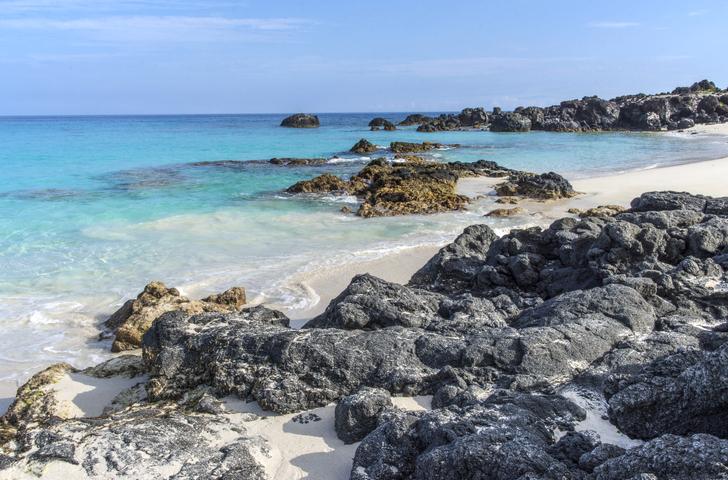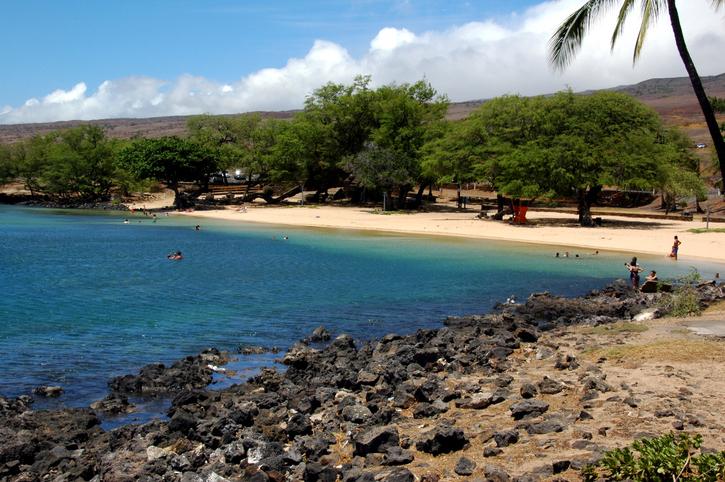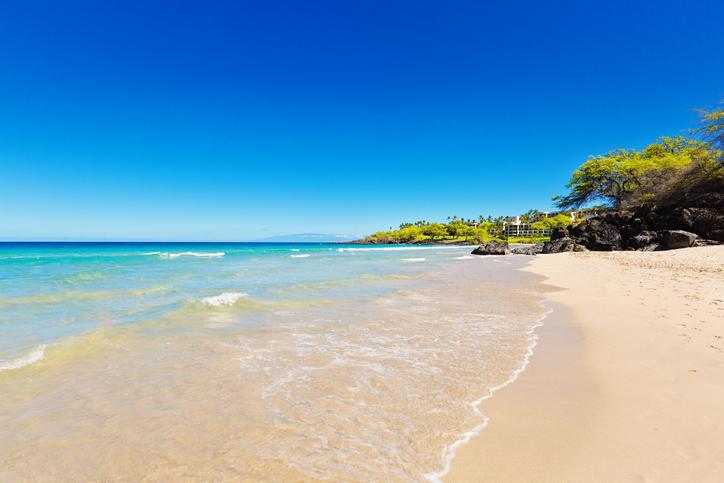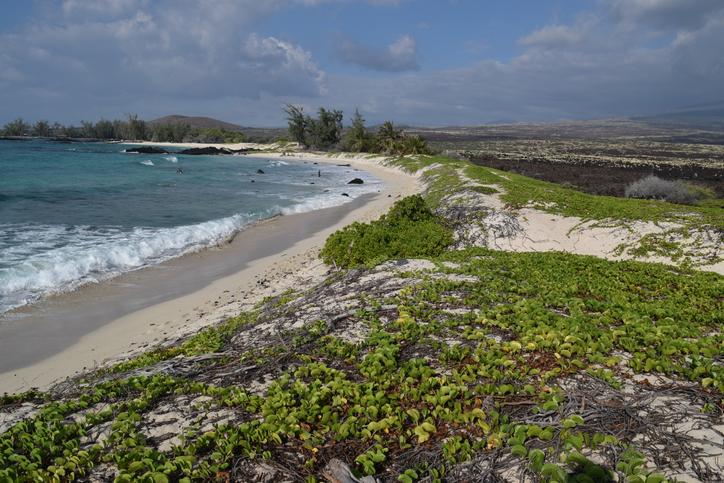The Big Island bears the name of the state -- Hawaii -- and it’s a wonder to behold. It’s the only Hawaiian island that is still growing. Its central active volcano is a national park, and the molten lava chooses a destructive path to the sea. Depending on the direction of the flow, you can watch the molten rock pour into the ocean to create a massive cloud of steam and glass.
The Big Island is big, and it continues to grow. The free-flowing lava grows the island by 40 acres per year, and the island’s impressive size demands a rental car. You’ll notice the land change dramatically as you drive around, and over, the island. Hawaii contains 10 of the world’s 14 different climate zones. You’ll find ski-able snow on Mauna Kea during the winter, and you’ll endure scorching deserts near Kona during the summer.
Mauna Kea is the largest mountain in the world if you measure from the ocean floor. The massive, occasionally snow-covered, mountain cuts the island in half. On its west, you’ll find Kona which is Hawaiian for “leeward,” or the side of the island less likely to see a storm. It’s hot, barren, dry volcanic rock fields balance the wet rainforest on the eastern side of the mountain. This is where you’ll find Hilo; the rainy metropolis of the east.
The size of Hawaii and the array of climate zones create many different beach experiences, but the youth of the island limits the number of swim-able beaches. The ocean hasn’t yet had an opportunity to grind the volcanic rocks and coral into sandy beaches, but, if you’re willing to drive around this massive island a bit, you’ll find some of the best swims in the world.
5. Kua Bay
 You can leave the less enthusiastic tourist crowds behind by descending to Kua Bay on the Big Island’s west coast for a good swim. The beach here is made up of white sand. That’s hard to find in Hawaii as the Big Island continues to grow. Most of the beaches are still made up of young volcanic rock.
You can leave the less enthusiastic tourist crowds behind by descending to Kua Bay on the Big Island’s west coast for a good swim. The beach here is made up of white sand. That’s hard to find in Hawaii as the Big Island continues to grow. Most of the beaches are still made up of young volcanic rock.
You’ll have to descend a wall of that rock to get down to Kua Bay’s crystal clear waters and soft sand. The beach sits at the bottom of a rocky climb about 100 yards away from the parking lot. You can find the parking lot by clicking on your odometer just as you pass Kona Airport driving north on Highway 11. Turn left into the parking lot as the odometer hits 4.6 miles. It’s the second exit on the left-right across from the West Hawaii Veteran’s Cemetery.
You’ll find showers and bathrooms at the parking lot, so keep that in mind as you descend the steep rocky incline to the beach. Once on the sand, you’ll be blown away by the crystal clear water and inviting waves. There is no lifeguard at Kua Bay, and the water can get a bit rough during the wintertime, so always check the surf reports before heading down.
Kua Bay is popular with locals, tourists, and wildlife. Turtles are often spotted in the water and lounging on the beach, and it’s not uncommon to see spinner dolphins jumping out of the water. Just make sure to get here earlier in the morning on a weekday to beat the crowds for the best swim possible.
There’s no shade at Kua Bay save for a lonely tree on the south side of the beach. That means you’ll be popping back into the water to cool down throughout the day. Only climb down to Kua Bay if you’re feeling very active and want to spend the day in the water.
4. Spencer’s Beach
 The Big Island is young. In fact, it’s still growing. This gives you access to lava flows, but it tends to make the beaches a bit rocky. That’s because the waves haven’t had enough time to smash the volcanic rocks down into tiny sand particles. But Spencer’s Beach, located on the Big Island’s northwest coast, is one of the few with soft white sand. There are no volcanic rocks here to ruin your swim.
The Big Island is young. In fact, it’s still growing. This gives you access to lava flows, but it tends to make the beaches a bit rocky. That’s because the waves haven’t had enough time to smash the volcanic rocks down into tiny sand particles. But Spencer’s Beach, located on the Big Island’s northwest coast, is one of the few with soft white sand. There are no volcanic rocks here to ruin your swim.
There’s a long reef just offshore that keeps the surging surf at bay. This all but guarantees perfect swimming conditions, and the calm waters are safe for the entire family.
Spencer’s Beach is picturesque. In fact, it almost looks man-made for its perfect half-moon shape, the idyllic palm trees lining the sand and the soft white curl of waves lapping at the beach. And those palm trees are a welcome sight on the scorching west coast of the Big Island. Put your towel down underneath the trees for some cooling shade as they help you to escape some of the sun damage you might get at another Big Island Beach.
You’ll often find a lifeguard on duty at Spencer’s Beach, and it’s always a good idea to ask a lifeguard where it's safe to swim in Hawaii. You’ll also find plenty of amenities like bathrooms, barbecues and picnic tables. You can make a whole day of it at Spencer’s.
But what makes the swimming world-class at Spencer’s is the long, slow slope of the sand. You gradually get deeper and deeper on soft sand as you walk into the water which allows you to pick an ideal depth for a good swim.
3. Hapuna Beach
 The Big Island has 10 of the world’s 14 different climate zones, and Hapuna Beach sits right in the middle of a dry zone. This beach only receives 10 inches of rainfall per year, so you can bet on a beautiful day at the beach. Unfortunately, everyone else knows this bit of information. It may be crowded so get there early in the morning.
The Big Island has 10 of the world’s 14 different climate zones, and Hapuna Beach sits right in the middle of a dry zone. This beach only receives 10 inches of rainfall per year, so you can bet on a beautiful day at the beach. Unfortunately, everyone else knows this bit of information. It may be crowded so get there early in the morning.
You’ll find this popular beach at mile marker 70 on Highway 19 north of Kona. You’ll have to pay a small fee to park in the lot, and it is not advisable to leave any valuables in the car. In fact, it’s best to leave the doors unlocked and the windows down to show the world that you have nothing to nab.
You’ll pass the Three Frog’s Cafe on your way down to the sand. That’s where you’ll find the beach’s facilities. You can also rent beach gear from the cafe. Items such as boogie boards, umbrellas, beach chairs, and snorkeling masks are available.
Snorkeling is great on Hapuna when the water is calm. It’s best to head on over to either end of the beach. The north features a fish-filled cliffside while the south has a coral-covered rocky point.
You’ll find plenty of shade at this popular beach. There are trees that line the back of the beach as well as beach pavilions. But there’s one thing you won’t find at Hapuna -- lifeguards. That means it is up to you to survey the safety of the beautiful blue water. It’s usually safe, but you can always look up the surf reports online before driving out.
The sandy bottom of the beach gradually sinks into the ocean to give you a variety of depths. The gradual incline makes this beach great for a family swim.
2. Makalawena Beach
 You’ll find this beach just north of Kona. Drive north of Kona Airport on Highway 19. The dirt parking lot is at the end of a road carved into the volcanic rock fields between mile markers 88 and 89. The road may appear rough, but a 2WD rental car should be able to make it. Just take it slow.
You’ll find this beach just north of Kona. Drive north of Kona Airport on Highway 19. The dirt parking lot is at the end of a road carved into the volcanic rock fields between mile markers 88 and 89. The road may appear rough, but a 2WD rental car should be able to make it. Just take it slow.
You’ll find a trailhead to this beach at the parking lot. The trail will take you through a volcanic rock field, so make sure to wear sturdy sandals or closed-toed shoes. You’ll have to trek about a mile on a beaten path through the lava field to the beach. You can see the first beach from the parking lot as it hides just behind a row of towering trees.
The sand here is white and the water is soft blue. The water is also incredibly clear, so it’s a good idea to take an underwater camera to capture some swimming shots. The trees provide shade on the beach, but you’ll have to lather yourself with sunscreen for the exposed walk out-and-back from the sand.
Sea turtles like to layout on the north end of the beach. Remember to enjoy the wildlife from a distance as the oils in your skin can degrade the turtle’s shell. In fact, it’s illegal to touch a sea turtle in Hawaii. But, if you tip-toe around the sleeping turtles, you’ll find a carved out staircase in the lava rock leading away from the beach.
The stairs take you up to another hiking path carved into the lava field. This one features lots of loose rocks that can move underfoot, so you should definitely be wearing protective footwear if you dare go to the second beach. But, if you brave the trek, you’ll be rewarded with seclusion.
Another white sand beach awaits you after another mile of hiking, but very few people ever make the journey. You might share the beach with a handful of others. The sand here is even softer, and the water is just as blue but deeper. It makes for an even better swim.
Just remember that there are no lifeguards at either of these beaches. Always check the surf report online before taking a swim. And remember that you have to hike back out across a hot field of lava rocks after your dip.
1. Green Sand Beach
 The United States only has two green sand beaches, and one of them is right here on the Big Island (the other is in Guam). It’s Hawaii’s hidden gem. You’ll have to work a bit to get to this spectacular and secluded beach, but it is well worth the effort. While it may not be the very best for swimming, it topped our list because of its rarity.
The United States only has two green sand beaches, and one of them is right here on the Big Island (the other is in Guam). It’s Hawaii’s hidden gem. You’ll have to work a bit to get to this spectacular and secluded beach, but it is well worth the effort. While it may not be the very best for swimming, it topped our list because of its rarity.
You’ll find this sparkling beach at the bottom of a cove on the southwest side of the island. The drive to the beach takes you past green, cow-covered pastures; the same green pastures that lured Portuguese cowboys to the island. This migration explains the Big Island’s favorite pastry -- the malasada.
You’ll have to drive to the southernmost point of the United States to get to the trailhead of this beach. Yes, you have to walk at least 2.5 miles to get to Green Sand Beach, but it is worth it. Take highway 11 south until you come across a dirt parking lot between mile markers 69 and 70.
You might find some locals toting tourists in the back of a pickup truck at the parking lot for a small fee. Feel free to take advantage of this service, but you need to hold on tight. The ride is rather bumpy with plenty of amazingly deep potholes. Otherwise, just walk along the coast until you get to Green Sand Beach’s cove.
The ocean has battered and smashed the coastal cinder cone into tiny little green olivine particles that mix with white sand and black volcanic rock particles to give the beach its stunning color, but, once you’ve reached the cove, your work is not over. You’ll have to carefully descend to the beach on a steep little trail that begins at the picnic table right where the locals unload their trucks of tourists.
The water is impossibly blue, and the ocean gets fairly deep just a few steps out. This short break makes for some nice body surfing waves, but the waves might be a little too rough for a safe swim during your visit. You can always check the surf conditions online before venturing out to this gem, and make sure to be careful as there are no lifeguards on Green Sand Beach. Plus, you’re a 2.5-mile bumpy truck ride away from any help.
But if the conditions are right, Green Sand Beach offers up one of the best swimming experiences in all of Hawaii. And you might swim alongside the sea turtles that are constantly found in the deep blue waters of this sandy bottom beach. Just make sure you take some time to float, look around at the cove and to drink in the beauty of this secluded beach’s green sand.